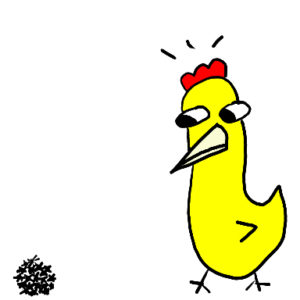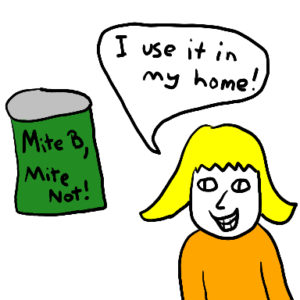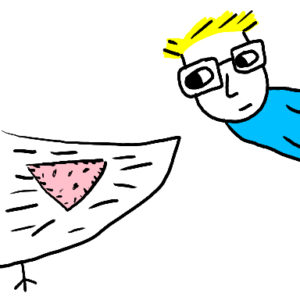New Frontiers In Mite Maintenance
Desperate times call for desperate measures, and mite infestations are nothing if not desperate times. I was powdering the poultry with the poultry powder, and I was protecting them with the Poultry Protector, and I did not see any progress. I may even have seen things get worse, but it’s always hard to tell once the mite ball gets rolling. And so, I returned to the internet to watch people fight, and to try to glean some helpful information out of what I witnessed.

Mite Ball – It’s a ball of mites! (Not available in stores.)
There seemed to be more options for mite control out there than when I last looked, or maybe it was just that the current situation had Steve (or John) losing feathers all up her back, which really worried me, and so I read more before I collapsed in an exhausted heap. I was very close to using dog and cat flea drops on them and then just throwing out the eggs for weeks afterwards, as horrible as that would make me feel. It seems so wasteful to just chuck eggs, but you don’t want to eat them if they’re toxic, and I obviously was ready for the big guns. Then I stumbled across a thread that pointed out how odd it was that no one was talking about the product they had come to use. Then they linked to a study showing that it was effective against mites, and that you could eat the eggs after using it. You just spray it on, and since it’s just topical, it doesn’t affect their egg system (though the flea stuff is topical too, but perhaps chickens are more absorbent in that case). And to make it easier, the person who started the thread explained the ratio of water to poison (yes, it’s still a poison) to use, so you didn’t have to use the complicated math in the scientific study. This was a dream come true, even if this explanation of it sounds like I fell for someone’s paid endorsement.

Chicken infomercials
The chemical is called Spinosad, and apparently it’s the by-product of some type of fermentation. This may or may not make it organic, and since what you buy in the store may actually be created synthetically instead of through the normal fermentation method, an argument about organicness broke out. I wasn’t so worried about what was organic or not at this point, I just wanted healthy chickens. So I bought one of the bottles of concentrate that contains this stuff, (there are a few different products by different brands) and mixed up a dose.

(file photo)
In spite of the fact that there’s a study about the effectiveness of this stuff on poultry mites, and that the company that holds the patent on this chemical says it’s cool for chickens, this is apparently still an “off label” treatment, unless maybe you buy the industrial vat of the pure stuff direct from the manufacturer. The concentrate I bought was for plants only, but the guru of it on the internet said this was good, and others backed up the claim, so I went in a-spraying. The chickens ran to the corner and tried to hide, but I got them all in their problem areas. Then I waited a week, and went in again. I even went in a third time a week after that. I’m not 100% sure, but it looked a lot like Steve (or John) was starting to grow back some feathers. This was a good sign.

Eternal vigilance is the price of feathers.
The issue I’m now running into is that chickens are waterproof. So you can spray them in the area where the feathers have been cleared out, but not anywhere else. In some cases, it looks like the mites have migrated to the waterproof areas, and begun defoliation. So I’ve sprayed those areas too. The other issue is that the way this stuff apparently works is to jump-start the mites’ metabolisms, so they basically work themselves to death. In some cases, the de-feathering got worse before it got better, since the mites got some last bits of feather eating in before their passing. I’m keeping an eye on things, but for now, this seems to be something that mites have yet to develop resistance to. Variety is not only the spice of life, it can also be the death of mites.
(CREDITS: Theme music: Chicken In The Barnyard by Fireproof Babies, Music Bed: Medley of Country Dances by Jaudas Society Orchestra)
Tags: backyard chickens, Bugs, chickens, Erik P. Kraft, hipster farming, mites, parasites

Quick question. One of our hens has been hopping the fence and laying eggs under a quince bush in the side yard. My husband found a stash of eggs there today. This is problematic because the bird escapes.
Any idea what this behavior is about? Or ideas on how to rectify this situation? They have a perfectly nice coop to lay their eggs in. The other birds are all laying in the boxes.
Thank you!
Hi Katie,
This is a tricky one. My birds sometimes start laying in weird places, but it’s usually just around the coop or the run. When that happens, I put a plastic Easter egg filled with sand in the nesting bucket, and within a day or two they remember how things are supposed to work. If the other birds are laying in the right place, that should be enough of an example, and I’m not sure why she’s escaping to do it. Is there a way to prevent her from getting at the bush? (Surround it with netting, or something?) I wonder if preventing access would send her back to the coop. If you haven’t already, check out backyardchickens.com, and either do a search, or sign up and post a question. They’ve always been very helpful to me there when I have tricky problems. I would bet someone there has had a similar issue and figured out a solution.
thank you! I will try the plastic egg trick. Strange bird, she goes to a lot of trouble to hide the eggs.